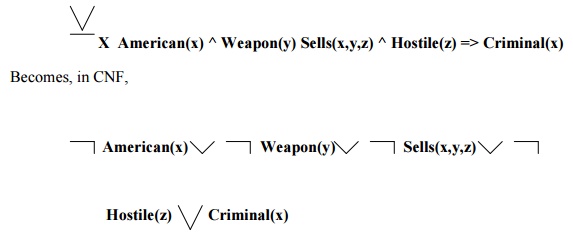Chapter: Artificial Intelligence
Important Questions and Answers: Artificial Intelligence Planning
1. What are the standard quantifiers of First Order
Logic?
The First
Order Logic contains two standard quantifiers.
They are:
i)
Universal Quantifiers
ii)
Existential Quantifiers
2. Define Universal Quantifier with an example.
To
represent “All elephants are mammal” “Raj is an elephant” is represented by
Elephant (Raj) and “Raj is a mammal”. The first order logic is given by

Elephant (Raj) => Mammal (Raj)
Elephant (John) => Mammal (John)
Thus it
is true if and only if, all the above sentences are true that is if p is true
for all objects x in the universe. Hence, is called universal quantifier.
![]()
3. Define Existential Quantifier with an example.
Universal
quantification makes statements about every object. Similarly, We can make
statement about some object in the universe without naming it, by using an
existential quantifier.
To say,
for example, that king john has a crown on his head, we write

x is
pronounced “There exists an x such that…..” or “For some x…”
The
sentence says that P is true for at least one object x. Hence, is called existential
quantifier.
6. What is the use of equality symbol?
The
equality symbol is used to make the statements more effective that two terms
refer to the same object.
Eg: Father (John) = Henry
7. Define Higher Order Logic.
The
Higher Order Logic allows quantifying over relations and functions as well as
over objects.
Eg: The two objects are equal if and
only if, all the properties to them are equivalent.

8. Define First Order Logic.
First
Order Logic, a representation language that is far more powerful than
propositional logic. First Order Logic commits to the existence of objects and
relations.
Eg: One plus two equals three
Objects - one, two & three
Relations - equals
Functions - plus
9. What is called declarative approach?
The
representation language makes it easy to express the knowledge in the form of
sentences. This simplifies the construction problem enormously. This is called
as declarative approach.
10. State the aspects of a knowledge representation
language.
A
knowledge representation language is defined in two aspects:
i) Syntax: The syntax of a language
describes the possible configuration that
can constitute sentences.
ii) Semantics: It determines the facts in the
world to which the sentences refer.
11. What is called entailment?
The
generations of new sentences that are necessarily true given the old sentences
are true. This relation between sentences is called entailment.
12. What is meant by tuple?
A tuple
is a collection of objects arranged in a fixed order and is written with angle
brackets surrounding the objects.
{< Richard the Lionheart, King John>,
<King John, Richard the Lion heart>}
13. What is Propositional Logic?
Propositional
Logic is a declarative language because its semantics is based on a truth
relation between sentences and possible worlds. It also has sufficient
expressive power to deal with partial information, using disjunction and negation.
14. What is compositionality in propositional
logic?
Propositional
Logic has a third property that is desirable in representation
languages,
namely compositionality. In a compositionality language, the meaning of sentences is
a function of the meaning of its parts. For example, “S1 ^ S2” is related
to the meanings of “S1 and S2”.
15. Define Symbols.
The basic
syntactic elements of first order logic are the symbols that stand for objects,
relations and functions. The symbols are in three kinds. Constant symbols which
stand for objects, Predicate symbols which stand for relations and Function
symbol which stand for functions.
16. Define ground term, Inference.
The term
without variables is called ground term.
The task
of deriving the new sentence from the old is called Inference.
17. Define Datalog.
The set
of first order definite clauses with no function symbols is called
datalog.
Eg: “The country Nono, an enemy of America”
Enemy(Nono, America)
The
absence of function symbols makes inference much easier.
18. What is Pattern Matching?
The
“inner loop” of the algorithm involves finding all possible unifiers such that
the premise of a rule unifies with a suitable set of facts in the knowledge
base. This is called Pattern Matching.
19. What is Data complexity?
The
complexity of inference as a function of the number of ground facts in the
database is called data complexity.
20. Define Prolog.
Prolog
programs are sets of definite clauses written in a notation somewhat different
from standard first-order logic.
21. What are the principal sources of Parallelism?
The first
called OR-Parallelism comes from the
possibility of a goal unifying with many different clauses in the knowledge
base. Each gives rise to an independent branch in the search space that can
lead to a potential solution and branches can be solved in parallel.
The
second called AND-Parallelism comes
from the possibility of solving each conjunct in the body of an implication in
parallel.
22. Define conjunctive normal form.
First
Order resolution requires that sentences be in conjunctive normal form that is,
a conjunction of clauses, where each clause is a disjunction of literals.
Literals can contain variables, which are assumed to universally quantified.
For ex,
the sentence

23. Define Skolemization.
Skolemization is the process of removing
existential quantifiers by elimination.
24. What is the other way to deal with equality?
Another
way to deal with an additional inference rule is
·
Demodulation
·
Para modulation
25.
Define
the ontology of situation calculus.
Situations,
which denote the states resulting from executing actions. This approach is
called Situation Calculus.
·
Situations
are
logical terms consisting of the initial situation and all situations that are generated by applying an action to a
situation.
·
Fluent are
functions and predicates that vary from one situation to the next, such as the location of the agent.
·
Atemporal
or eternal predicates and functions are
also allowed.
Related Topics